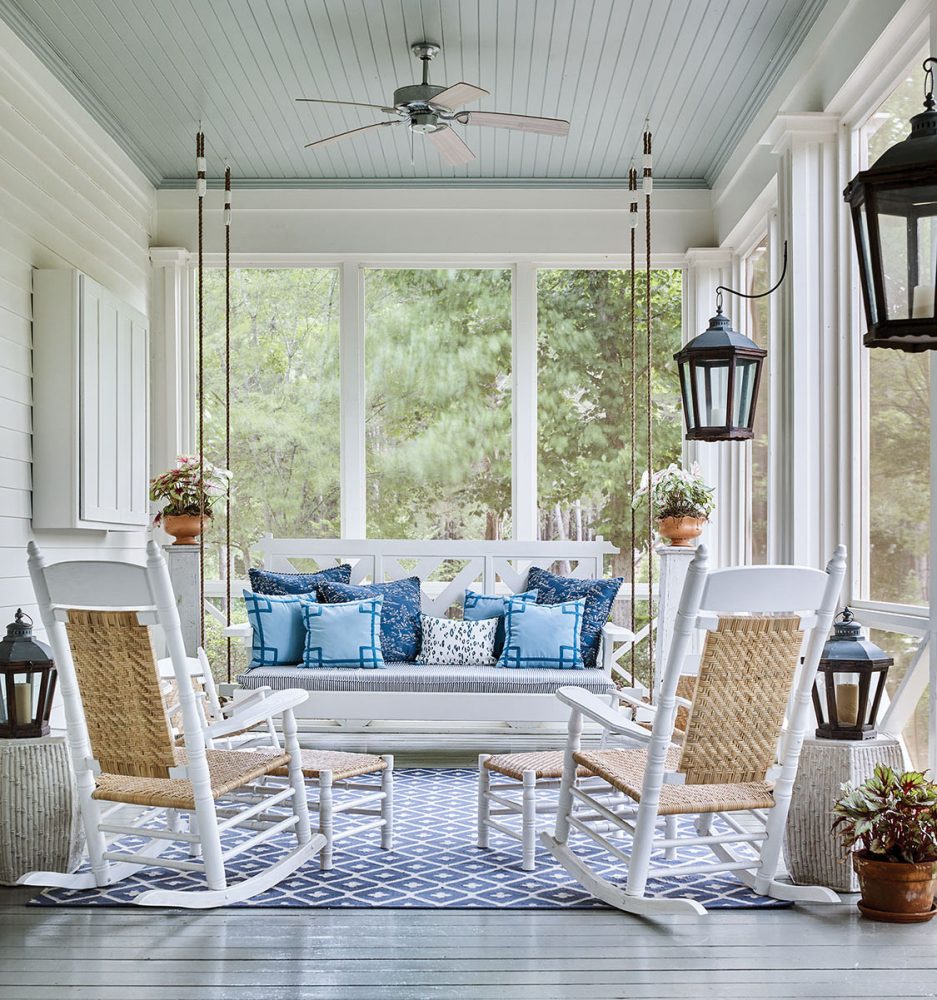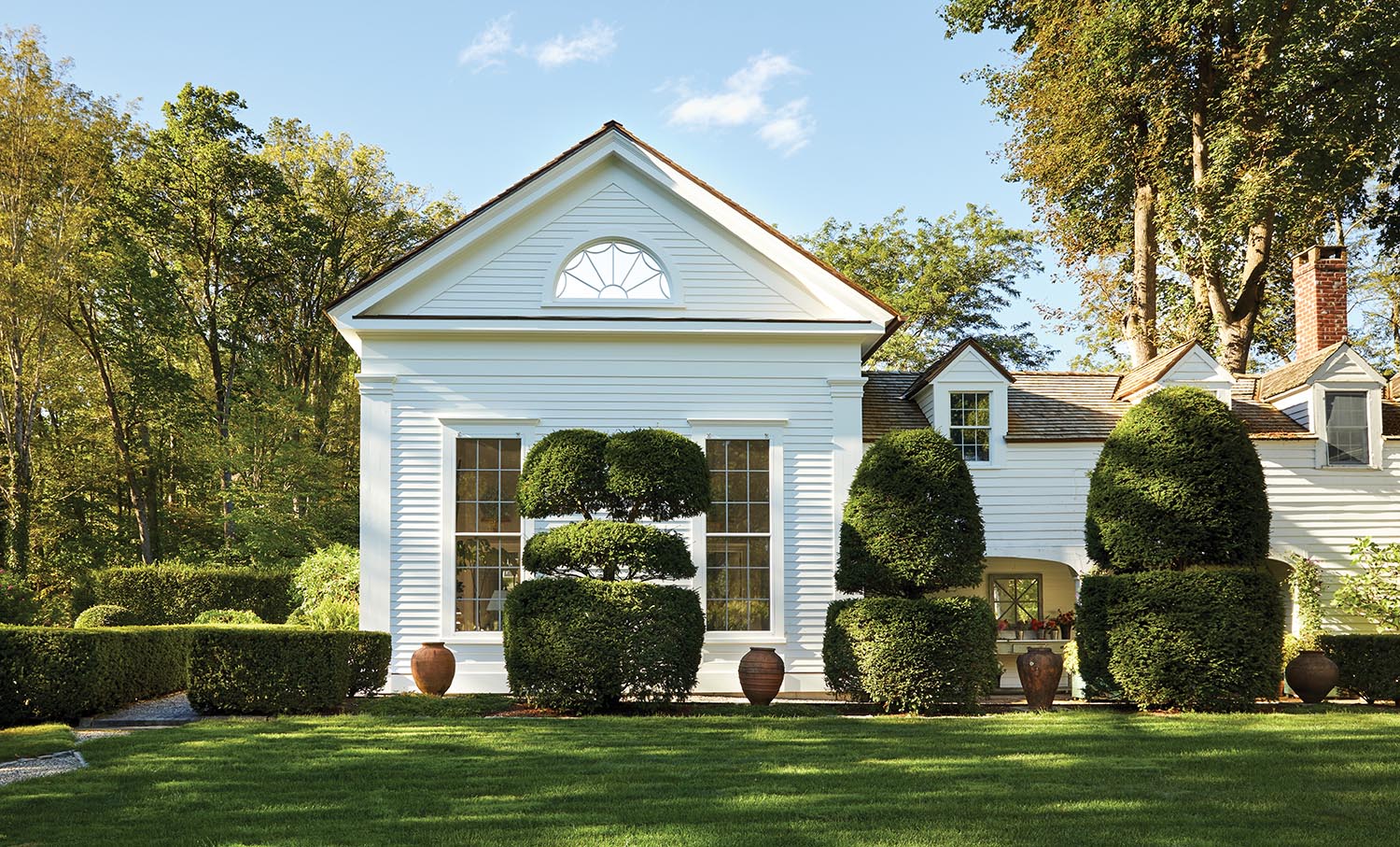
Photo by Annie Schlechter
"Whether it was the large allée of mature locust trees that lined the driveway ending at a huge catalpa tree, or the two imposing sugar maples that flanked the white house sitting on a slight knoll, it was love at first sight and, as such, I saw no faults."—Bunny Williams, LIFE IN THE GARDEN
Margot Shaw, FLOWER magazine: Hi, Bunny! First of all, your new book, Life in the Garden is a masterpiece. What a tremendous undertaking! Congratulations. What inspired you to create this oeuvre?
Bunny Williams: Seeing Annie Schlechter’s photographs inspired me to create this book. I’m very close to the garden–I see it almost everyday–but viewing it through her eyes allowed me to see an emotion and a romance in the garden on film that I don’t think anyone had captured before. That, along with the photographs that my nephew James Gillispie took. He takes photos everyday of the flowers that are in bloom–specimen photos of a Queen Anne’s lace, or a sunflower, or a tulip. When I looked at this combination of photography, I saw a book, and it made me want to create something different.
I love your Elizabeth Lawrence quote early in the pages; “There’s a garden in every childhood, an enchanted place where colors are brighter, the air softer, and the morning more fragrant than ever again.” What was YOUR childhood garden like? And is there a garden memory that lingers?
My childhood garden was mostly a vegetable garden. When I was very little, I used to go out with my mother and a little trowel, and she would be picking tomatoes or staking this and that. And we had this lovely lady who worked on the property, Mrs. McAllister. I remember the joy of being outside, digging in the dirt, planting something, helping my mother. I loved it. You know– you plant something–and then you pick it. I remember picking the peonies to come in the house and smelling them and how delicious they were. That made me love the idea of gardening and growing things.

Photo by Annie Schlechter
Bunny converted an 18th century shed that was on the property into a "basket house."
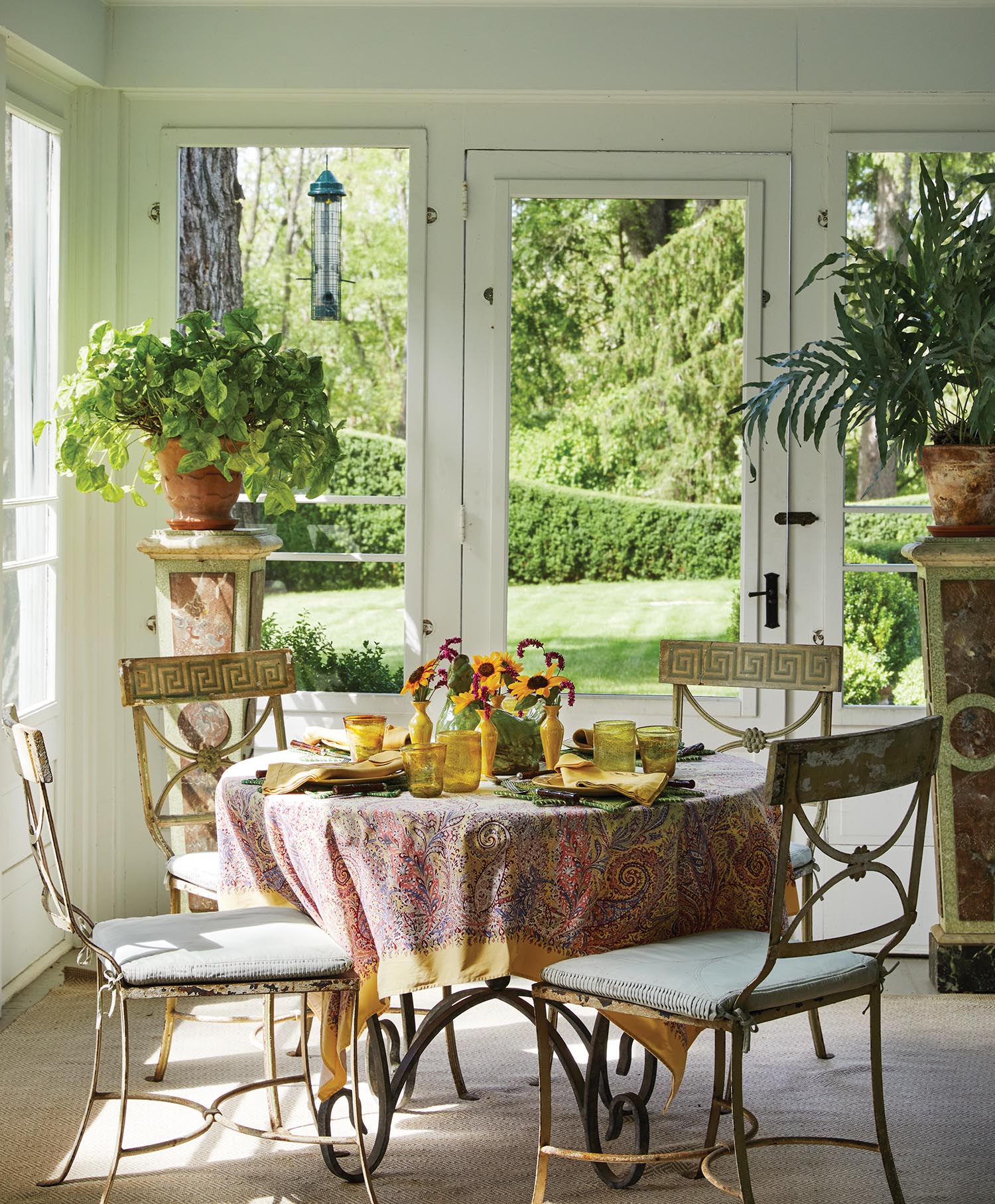
Photo by Annie Schlechter
On a warm summer's day, fresh flowers from the garden decorate a table, making it the perfect spot to enjoy a bite while taking in the scenery.
When I first visited your gardens during Trade Secrets, I was agog, transported, and a bit intimidated by the scale, beauty and perfection. You responded so graciously— “Margot, I’ve been here 30 years.” What dedication! Can you sketch for us the evolution?
I started first with what is now the Sunken Garden. Once I did one area, it just seemed to me that, “Oh, well I could do this!” The gardens came together as we developed the property. For instance, when we decided to convert the barn into a real house with a room and we added the conservatory to it— it immediately made me want to have the parterre garden behind it. So much of the gardens is their relationships to the buildings. A lot of the development of the garden came over a period of time, and as we developed another part of a building, that allowed us to create another garden.
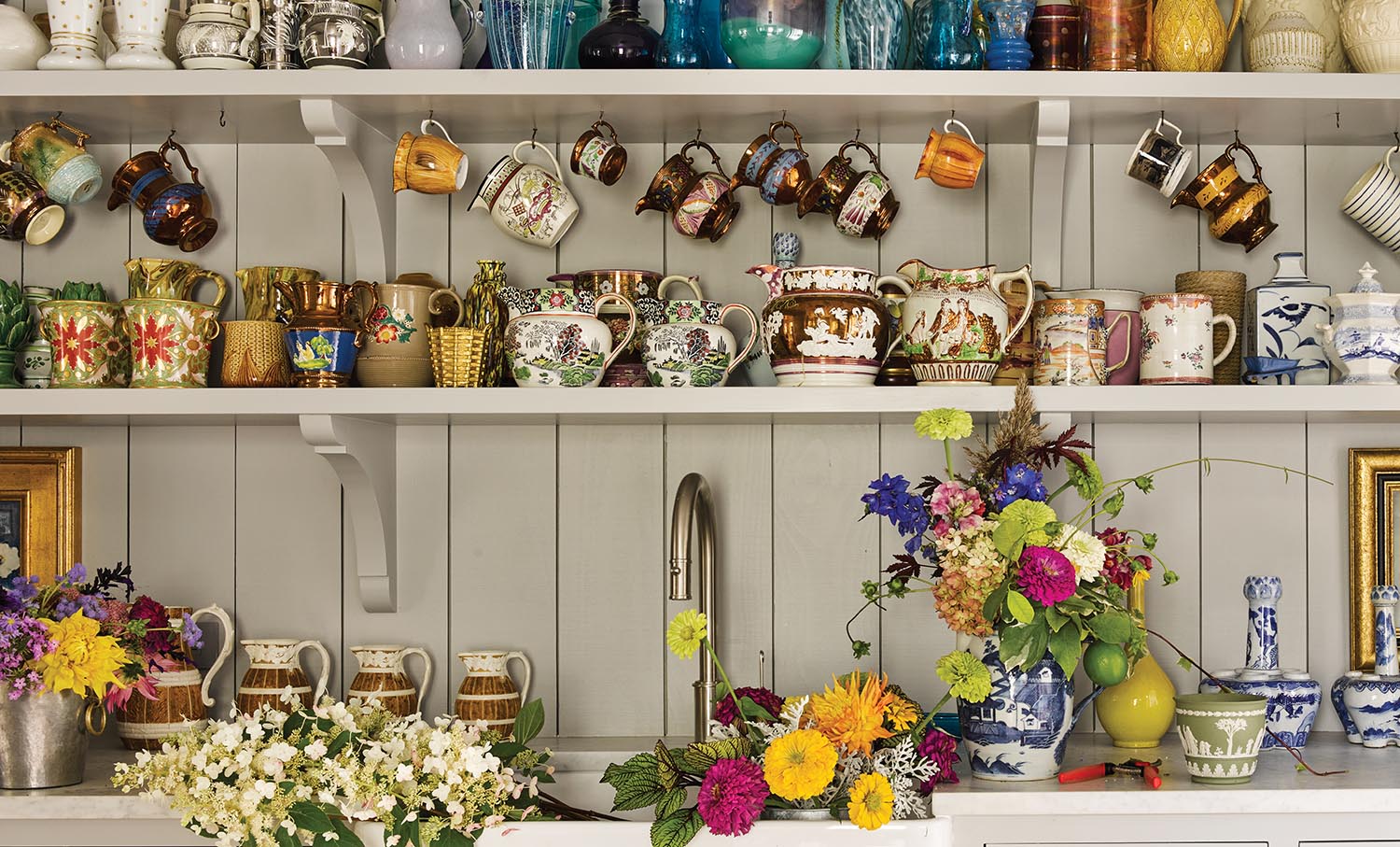
Photo by Annie Schlechter
"Since I so enjoy arranging flowers, I created a small area off the kitchen just for that purpose. Above a marble-top counter with a sink, I mounted long shelves that hold many of my containers while, in drawers underneath, I keep my clippers, scissors, frogs, and chicken wire so everything I need is within reach."—Bunny Williams, LIFE IN THE GARDEN
In the book you talk about the role travel has played in your garden design— Sissinghurst, Hidcote, Jardin Majorelle, etc. I LOVED that you wanted to bring the Majorelle blue home, but knew it wouldn’t work in Northwestern Connecticut. Can you talk about that? And what colors DO work and why?
As much as we travel and look at gardens, we always have to remember to come back to where we are and the kind of house that we have, which will affect the kind of gardens you create. I have a traditional house, and my gardens tend to be more traditional. If I had a contemporary house, I wouldn’t have the gardens that I have— they might be more modern or inspired by something else. You always want there to be a harmony between the house and the gardens that connect to them.
If you live in California, bright colors look fabulous, just like they do in Morocco. In Connecticut, the light is softer, and we have a lot of stone walls. Natural materials— bricks, terracotta, stone pots and pathways— look like a part of the earth. It doesn’t mean you can’t paint something a bright color in your garden, but there has to be a harmony in the statement you want to make and the kind of garden you have.

Photo by Annie Schlechter
"After the tulips have finished blooming, they are removed to make space to plant a combination of annuals for summer blooms. Each year we try different colors— most recently pink and orange, but probably my favorite was a mix of white and cream."—Bunny Williams, LIFE IN THE GARDEN
What elements from those great gardens have you adopted/adapted?
One thing that I learned is that garden rooms need connections. The one thing that is different about my gardens from many that I’ve gone to see is that I have negative space. My sunken garden is very complicated, but to lead to the next garden, you go through serene clipped hedges and green lawn to then get to the Parterre, another complicated garden. I find that gives me a place to relax in between.
Your quote by Gertrude Jekyll “In garden arrangement as in all other kinds of decorative work, one has not only to acquire a knowledge of what to do but also to gain some wisdom in perceiving what it is well to let alone.”
What wisdom have you gleaned when it comes to letting alone in the garden? In interiors?
I could look out and say yes, I could create another garden. It’s the same as well, in interiors. If you put all your ideas in one room, it can become claustrophobic. If I’ve got a complicated room, maybe the hallway off of it is simple. We need places for our eyes to relax.
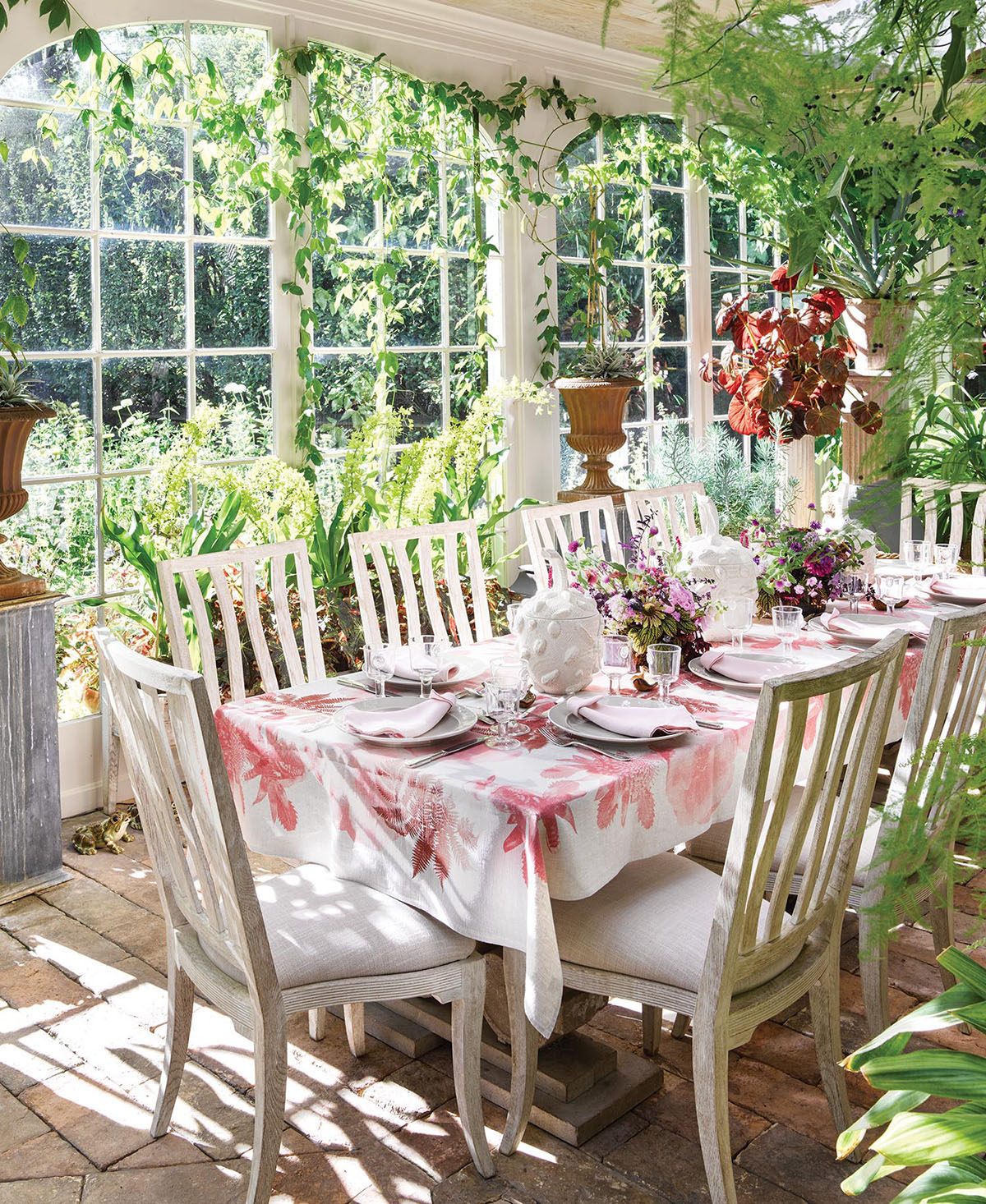
Photo by Annie Schlechter
"One of my favorite tablecloths from Boxwood Linen in Chatham, New York, sets the color scheme for this dining table on the conservatory. The flowers are arranged between Christopher Spitzmiller bisque gourds."—Bunny Williams, LIFE IN THE GARDEN
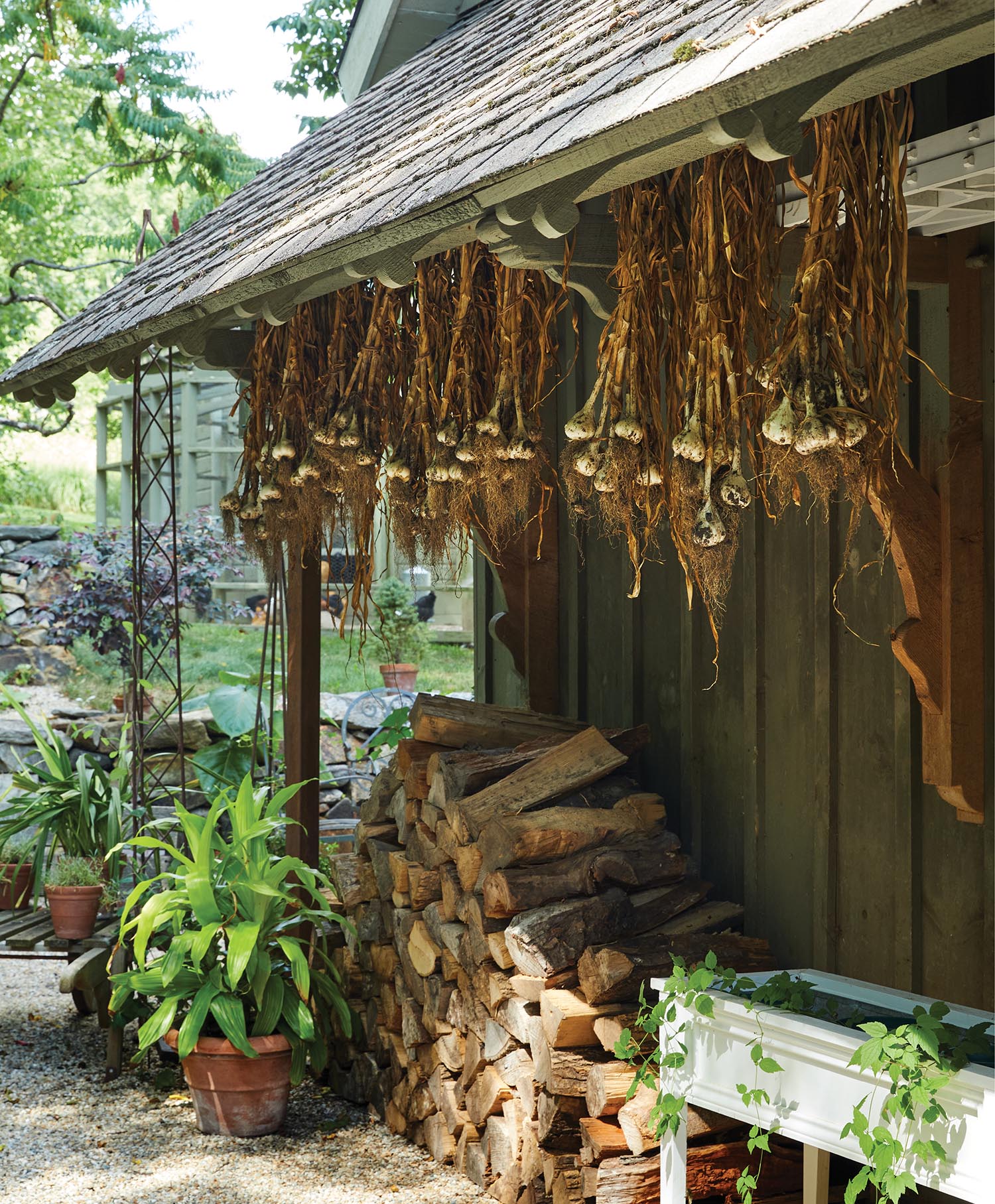
Photo by Annie Schlechter
"In the fall, we can store dormant bulbs for forcing in the late winter. The exterior of the greenhouse was not very attractive, so I added an open pattern of wooden lathing strips to add interest while hiding the vinyl panels."—Bunny Williams, LIFE IN THE GARDEN
Talk about how you decide what garden statuary, furniture, and architecture you’ve chosen through the years and what determines where it’s placed.
What’s interesting about garden statuary is that in some cases, you need a punctuation point. Maybe at the end of a walkway or a vista. So sometimes, you’re looking for something specific for an area in your design. When you go down a walkway, what do you see in the distance? Maybe it’s a big stone urn.
Other times, you just see something you fall in love with. I fell in love with this beautiful figure of Atalanta and I didn’t really have a place for her. And then I thought; “Why not put her in the woodland?” Totally unexpected, and yet I love the sense of this metal figure of a woman throwing her apple down the hill, in contrast to the naturalness of the woodland garden.
I am always looking for benches because I think there should be a place to sit wherever you are in the garden. My woodland garden has faux bois benches because they look like a part of the woods, whereas the benches along the house are either metal or teak. It’s often about finding an interesting one. I have a Russian bench that’s on my side porch just because it was so special that I had to have it.
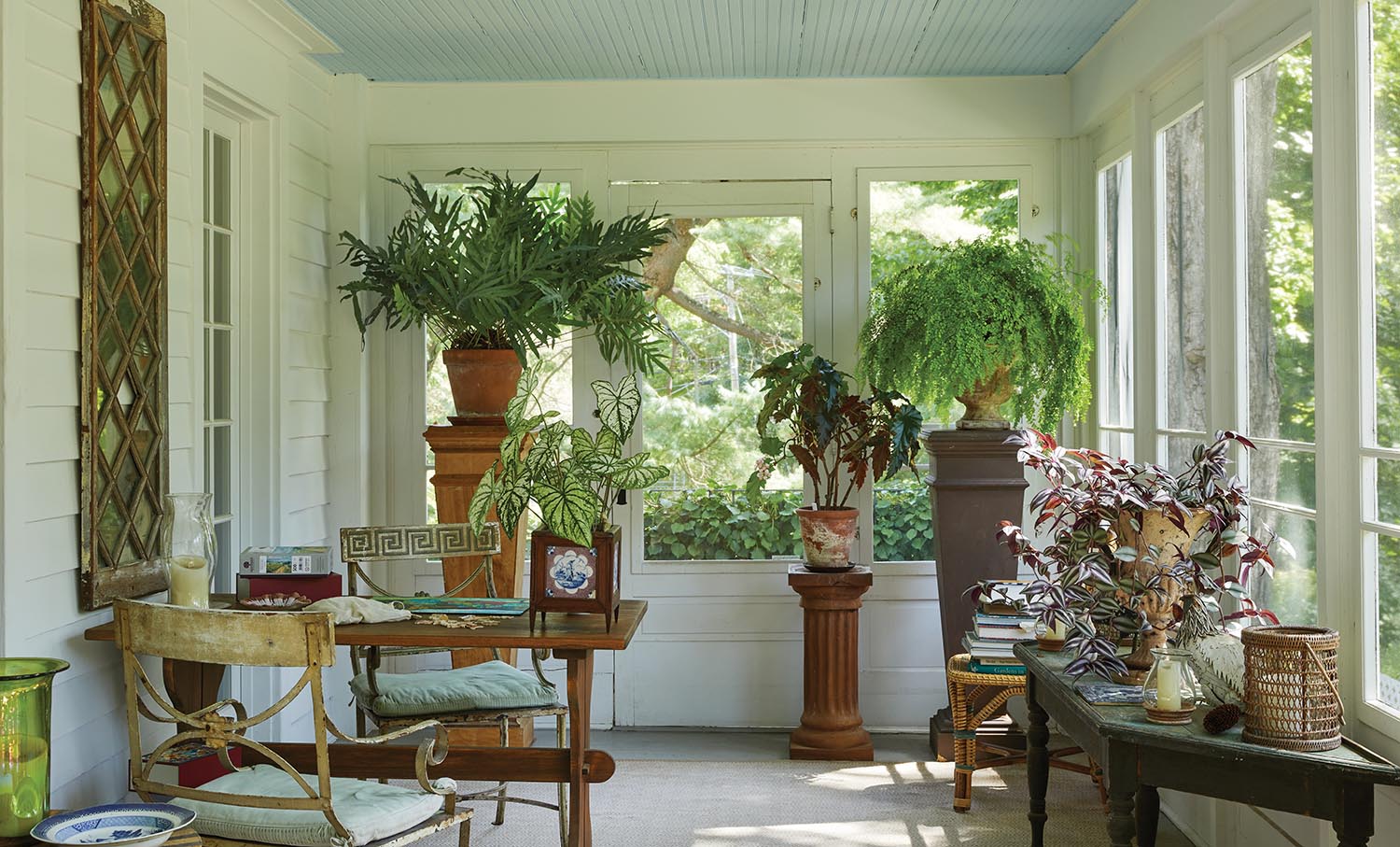
Photo by Annie Schlechter
"We are very fortunate to have indoor spaces to retreat to during the winter months. The conservatory has begun to feel (in my imagination) like the hanging gardens of Babylon, with vines weaving through clear fishing line supports that cascade over the windows."—Bunny Williams, LIFE IN THE GARDEN
Which leads me to ask about the inspiration for the perfect pool and pavilion.
John decided we needed a swimming pool, and we found this beautiful stone coping from a bassin in the south of France. I didn’t want a pool near the house because we can only swim two months out of the year. So I looked at my property and decided to put the pool house up on a hill, so I would be able to walk through the orchard to get to it. Behind the pool house is the woods, and I wanted it to look like a part of the woods. Since Falls Village, Connecticut is filled with Greek Revival architecture, I immediately thought of a Greek Temple. Greek Temples were originally made of wood, and the logs make it look like it has emerged from the woods. That was my inspiration for the temple on the hill made of logs.
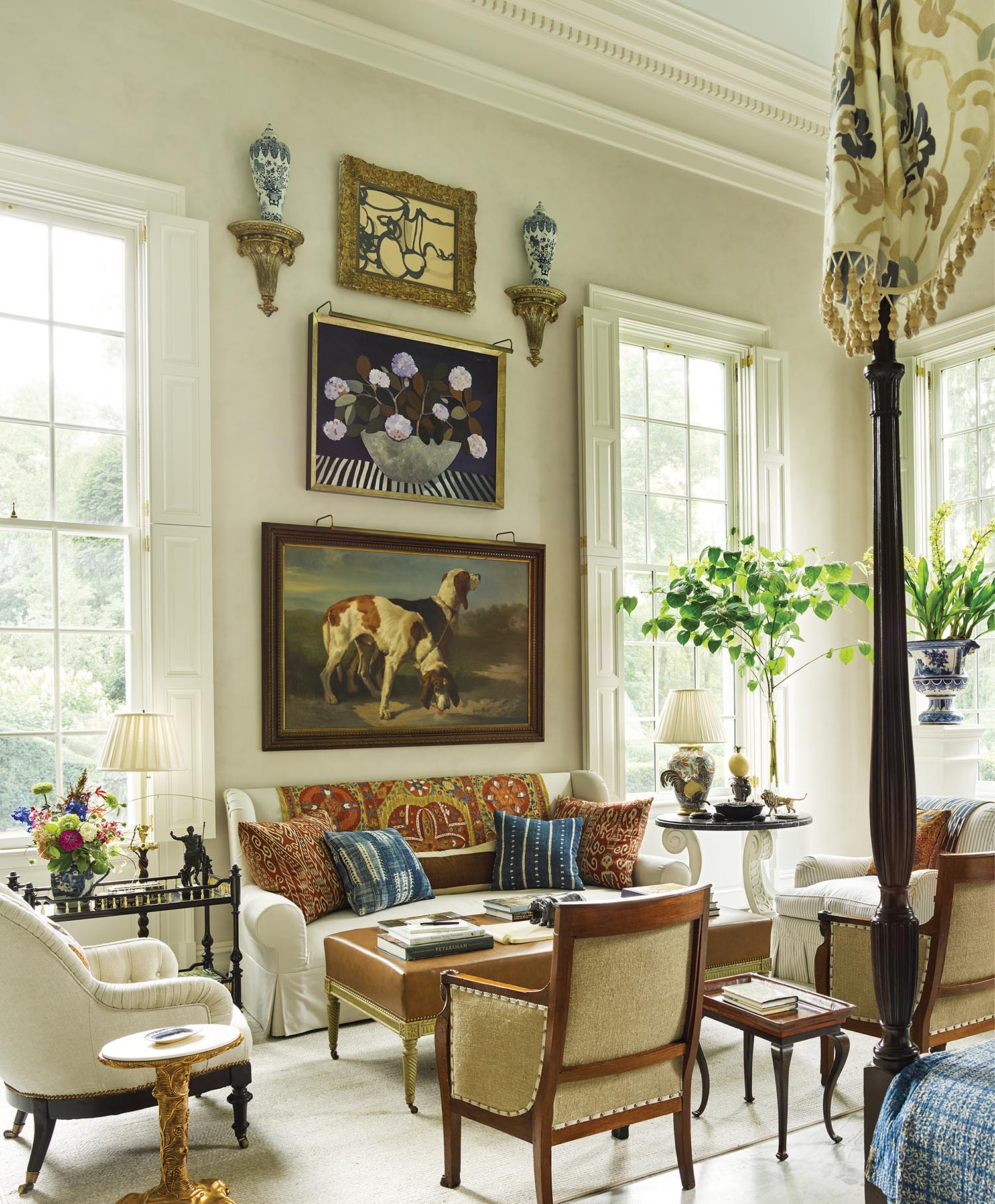
Photo by Annie Schlechter
The new sitting bedrooms always have branches and plants from the garden. Paintings are stacked to punctuate the height of the eighteen-foot ceilings.
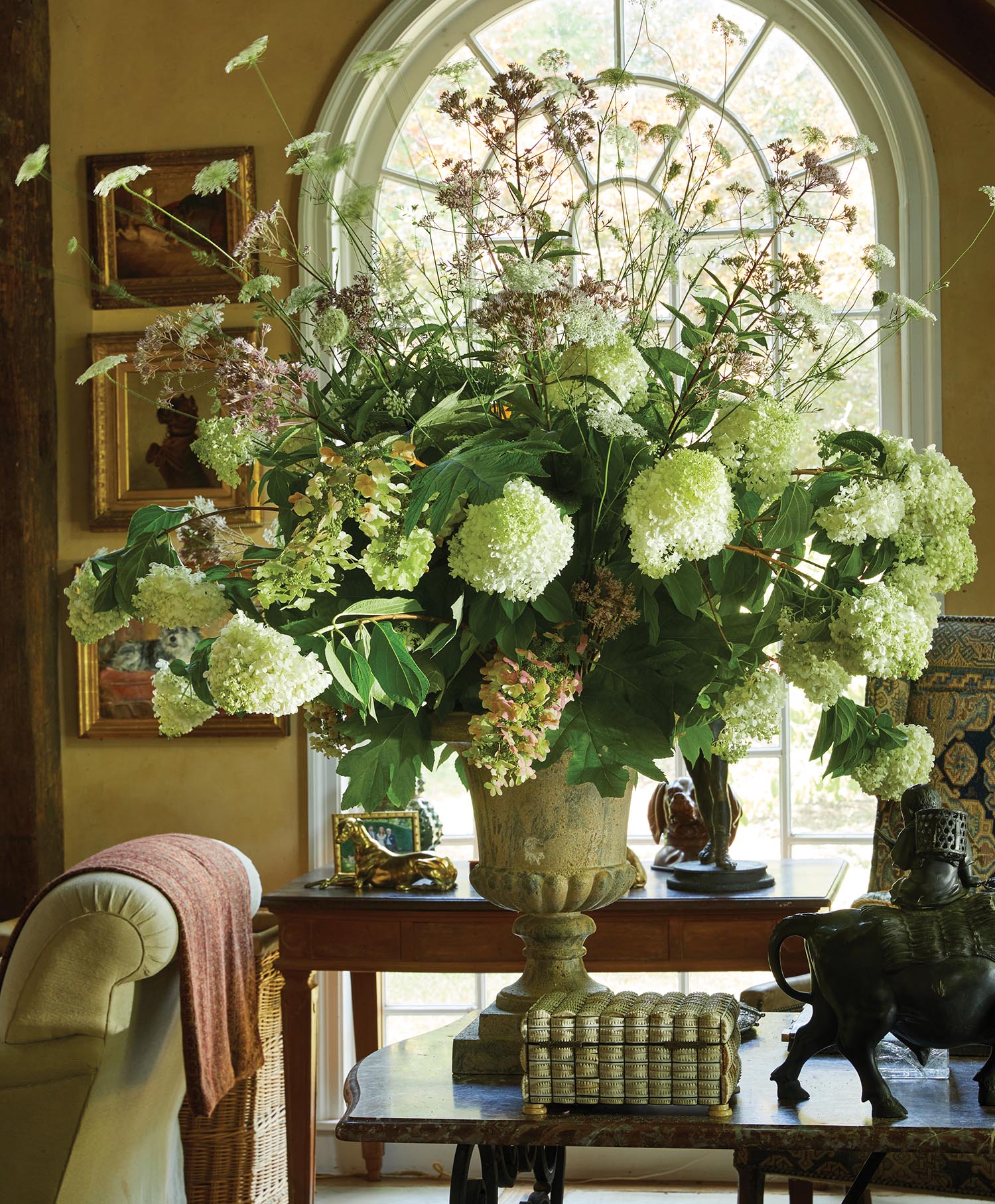
Photo by Annie Schlechter
A large fiberglass urn filled with flowers and shrubs adds exciting scale to the high-ceilinged barn living room.
Along with your interior and garden design talent, you are a wonderful flower arranger. There’s a lot of cutting from your garden. Can you describe your style, favorite palette, and how you select containers, as well as how you’ve collected them?
I always want my flower arranging to look as natural as possible. I love to cut from the garden and even assemble a little bouquet in my hand. You need different textures and filler— a begonia leaf or coleus foliage to then add the flowers to. You want the flowers to be tighter at the bottom and then get airier at the top. So if there’s a long stem, it can be by itself, and then you’ll see the flowers more. I’m not a fan of cramming too many flowers in a vase because then you can’t really see them. Often, a flower gets prettier as it opens, and you can enjoy the arrangement longer.
I have every kind of container known to man. Some of the simplest ones are those that have a fat bottom and a narrow opening. They hold plenty of water, and the shape makes it easy to hold the flowers together. Then I have a big vase for arrangements in the barn— a huge urn. Some of my containers are scaled for the place that they’ll go. I love to use a big blue-and-white ginger jar or a glass container for flowers in the front hall.
I’ve also fallen in love with lily vases which are tall, thin glass vases, perfect for the simplest arrangement. You can just cut a beautiful branch and put it in there, and it’s absolutely beautiful while adding scale and height to a room.
All your books, of course, have a personal voice, but this one seems almost a paean to your garden and family. Talk about “Magic Making at Aunt Bunny’s.”
Looking back over the years I realized that this house–and one of the reasons why I’ve kept it so long and lived there– it’s been a place for my family for every holiday. I asked my nephew to write “Magic Making at Aunt Bunny’s” because he’s been coming here since he was a child, and I do think that he captured that spirit. Now his children are coming to visit. That to me is what a house is all about. You share it, whether it’s with your family or your friends. It’s your place to help make magic by setting the dinner table, or having a picnic, or just an afternoon tea. It’s a gift that you can give to your friends and the people that you love.
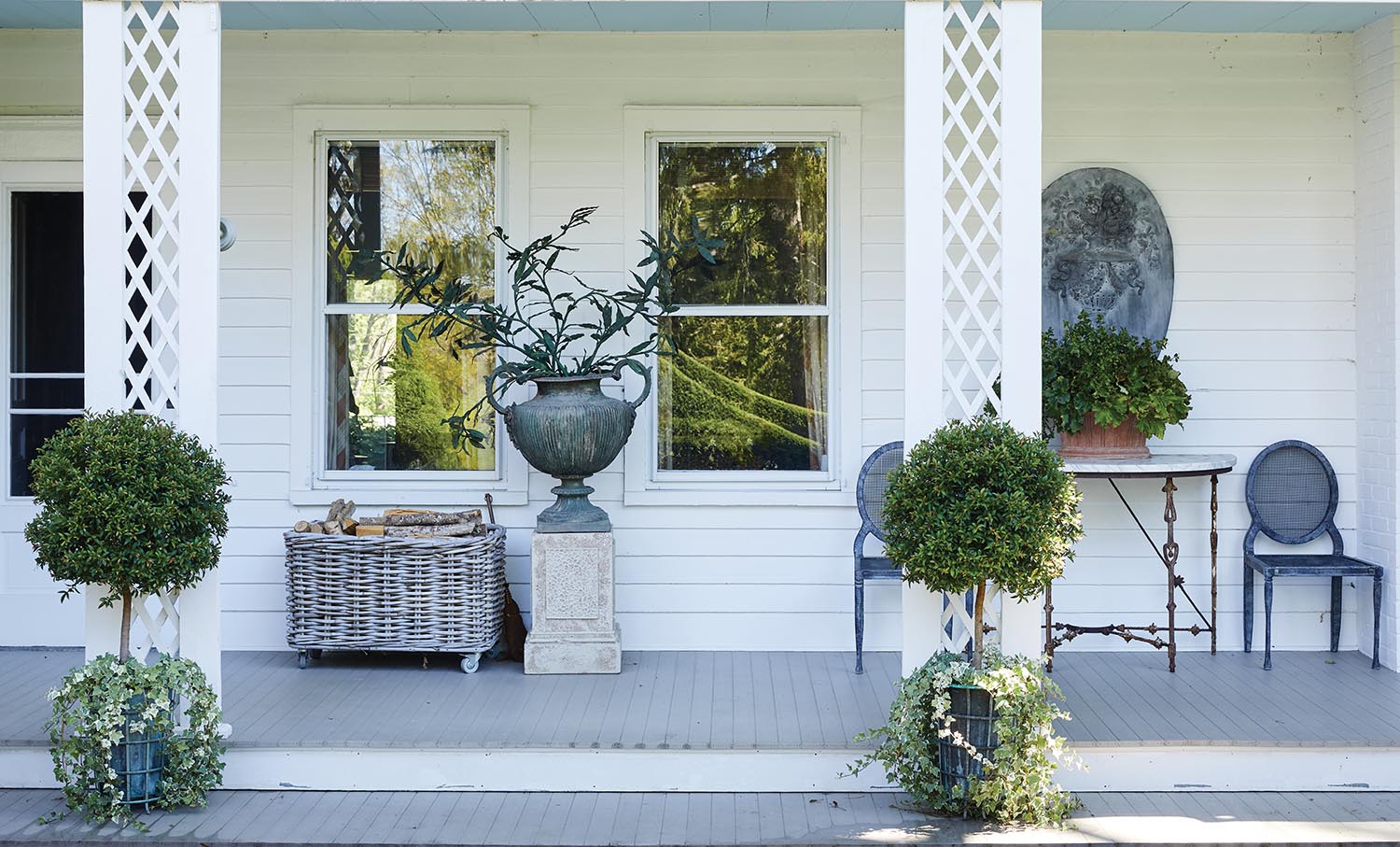
Photo by Annie Schlechter
"I’ve had the same two iron urns on my front terrace for years; in the warm months I fill them with large ferns or acanthus, and as winter approaches I replant them with small evergreen trees that I can wrap with small white lights at Christmastime."—Bunny Williams, LIFE IN THE GARDEN
There are several mentions in the book of being still and being thankful. What are some of your favorite spots, and can you reprise your thanks?
We often go into the various gardens at a particular time of day. For instance, on a very hot day, I’ll go up and sit in the Woodland Garden, which is always shaded, and watch the dappled light coming through the trees. When you sit there and take in nature, you have to be thankful.
Working in the vegetable garden, even in the hot afternoon when you’re trying to pick things for dinner, you just marvel over the fact that this plant produced these delicious tomatoes, or potatoes, or onions. The garden is beautiful, but there you are cutting it and putting it in a basket and taking it in to make dinner.
And you must find time for it. John loves to go feed the fish, so we go into the sunken garden and sit there with the dogs in the late afternoon and have a glass of wine and just chat.
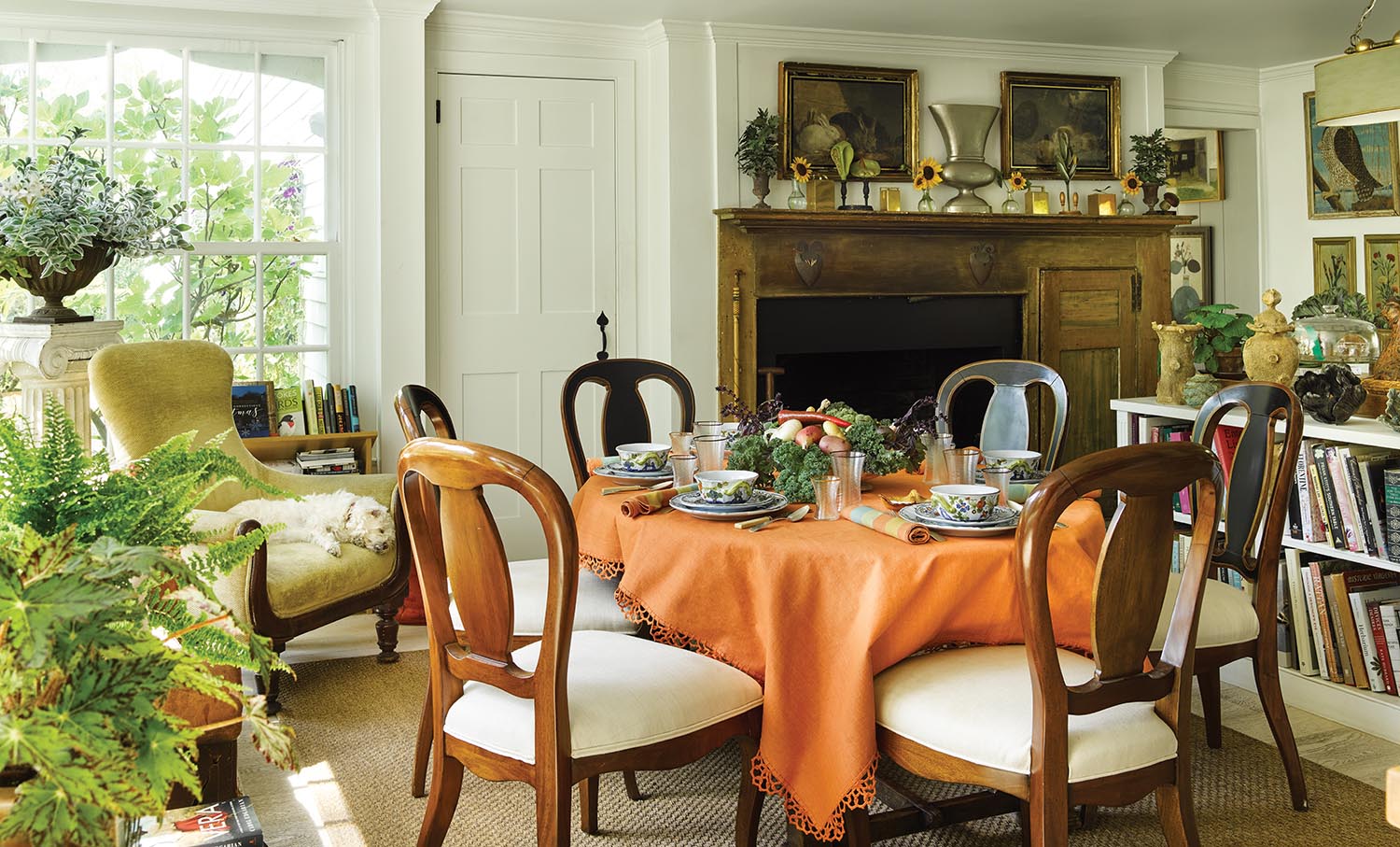
Photo by Annie Schlechter
"If you were lucky enough to grow up in the South, hospitality is something that you learned about early on. From christening, birthday, and engagement parties to Easter egg rolls and large cocktail buffets where all age groups were included, there just seemed to be something exciting and sociable happening all the time." —Bunny Williams, LIFE IN THE GARDEN
You’re so prolific, Bunny, can you touch on your latest ventures in the world of home furnishings?
What’s exciting about having a company like Bunny Williams Home is that everywhere you go you see something and think, “Isn’t that a good idea!” You are absorbing the things that you see and thinking a lot about the question “What do people need?” We try to design with that in mind. The Great Coffee Table. The Perfect Bedside Table. You’re constantly thinking about what is needed most and what’s hard to find, so the ideas are endless.
All our best for a wildly successful book and tour!
By Margot Shaw | Photography by Annie Schlechter

With the help of stunning photography from Annie Schlechter, Bunny Williams takes readers on an intimate journey through her garden at her Connecticut home. Filled with personal anecdotes and gorgeous images, Life in the Garden is sure to inspire readers in their pursuit of a beautiful life.
By Bunny Williams
Photography by Annie Schlechter
Excerpted from Life in the Garden (Rizzoli 2024)
Buy the book to see more stunning photos of Bunny’s garden!


